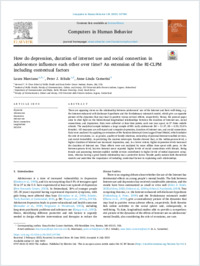How do depression, duration of internet use and social connection in adolescence influence each other over time? : an extension of the RI-CLPM including contextual factors
- Marciano, Laura Institute of Public Health (IPH), Università della Svizzera italiana, Switzerland - Harvard T. H. Chan School of Public Health and Dana-Farber Cancer Institute, Boston, MA, USA
- Schulz, Peter J. Faculty of Communication, Culture and Society, USI Università della Svizzera italiana, Lugano, Switzerland - Department of Communication and Media, Ewha Womans University, Seoul, South Korea
- Camerini, Anne-Linda Institute of Public Health (IPH), Università della Svizzera italiana, Switzerland
- 2022
Published in:
- Computers in human behavior. - 2022, vol. 136, p. 107390
English
There are opposing views on the relationship between adolescents’ use of the Internet and their well-being, e.g. the Internet-enhanced self-disclosure hypothesis and the Evolutionary mismatch model, which give an opposite picture of the dynamics that may lead to positive versus adverse effects, respectively. Hence, the present paper aims to shed light on the bidirectional longitudinal relationships between the duration of Internet use, social connections, and depression. Data were collected at four time points, each one year apart, in 37 Swiss middle schools. The analytical sample includes a large sample of 981 early adolescents (M = 11.37, SD = 0.55; 53.9% females). All measures are self-report and comprise depression, duration of internet use, and social connection. Data were analyzed by applying an extension of the Random Intercept-Cross Lagged Panel Model, which includes the role of covariates, i.e. as gender, quality of family relations, ownership of personal Internet-enabled devices, and social desirability, in predicting the random intercepts. Results showed that, at the within-person level, a higher duration of Internet use increased depression, and, to a lower extent, higher depression levels increased the duration of Internet use. These effects were not mediated by more offline time spent with peers. At the between-person level, heavier Internet users reported higher levels of social connections with friends. Being female and possessing Internet-enabled mobile devices contributed to higher levels of initial depressive symptoms, whereas having a good family relationship was a protective factor. Results partly sustain both theoretical models and underline the importance of including contextual factors in explaining such relationships.
- Collections
- Language
-
- English
- Classification
- Information, communication and media sciences
- License
- Open access status
- hybrid
- Identifiers
-
- DOI 10.1016/j.chb.2022.107390
- ARK ark:/12658/srd1322455
- Persistent URL
- https://n2t.net/ark:/12658/srd1322455
Statistics
Document views: 160
File downloads:
- Marciano_2022_Else_chb: 413
